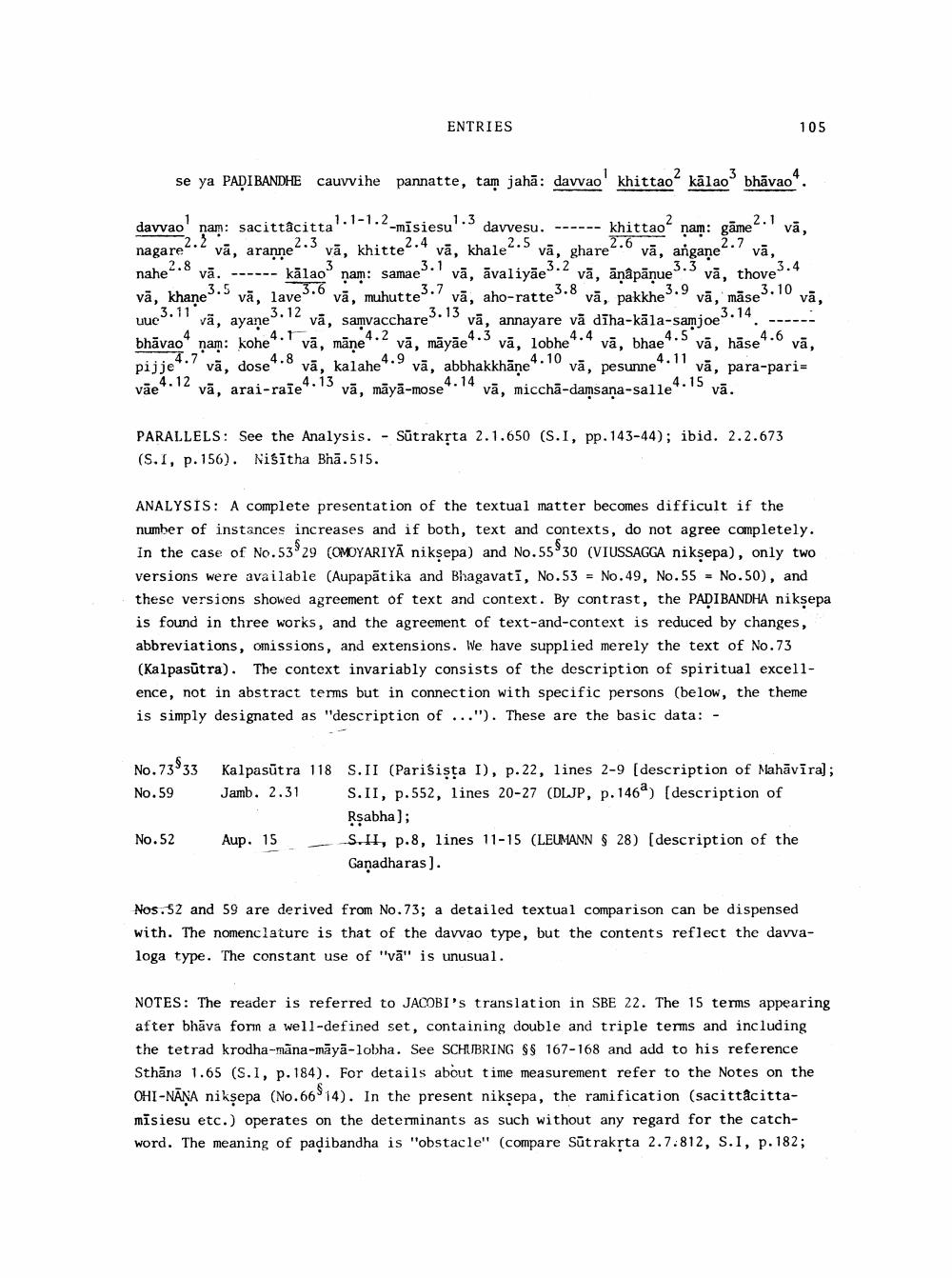________________
➖➖➖➖➖
se ya PADI BANDHE cauvvihe pannatte, tam jaha: davvao khittao2 kalao3 bhāvao4.
2.1
1.1-1.2
2.2
2.8
3 3.6
3.7
vā,
davvao nam: sacittâcitta' 2-mīsiesu1.3 davvesu. khittao nam: game 2.6 2.7 nagareva, arange2.3 vā, khitte2.4 v, khale2.5 vā, vā, ghare vā, angane vā, 3.2 3.3 3.4 nahe vā. kālao nam: samae vä, valiyeva, aṇāpāņue3 sanae3-1 vā, vā, thove 3.5 3.8 3.9 3.10 va, aho-ratte3 va, lave vā, muhutte3 vā, pakkhe vā, mase va, sapvacchare3.13 bhāvao nam: kohe vā, māņe vā, nāyāe māyāe 4.3 dose vā, kalahe 4.9 arai-raie" vā, māyā-mose vā, miccha-damsana-salle vā.
vā, khane 3.11 uue vä, ayane
3.12
4.1
4.2
4.4
vā, annayare vā dīha-kāla-samjoe3.14 vā, lobhe" vā, bhae" vä, vā, häse4.6 vā, vā, abbhakkhāne 4.10 vā, pesunne vā, para-pari=
4.5 4.11
4.8
4.7 pijje 4.12
vā, vā,
4.13
4.14
4.15
vae
PARALLELS: See the Analysis. (S.I, p.156). Niŝitha Bha.515.
ENTRIES
No.52
------
Aup. 15
105
Sūtrakṛta 2.1.650 (S. I, pp. 143-44); ibid. 2.2.673
ANALYSIS: A complete presentation of the textual matter becomes difficult if the number of instances increases and if both, text and contexts, do not agree completely. In the case of No.5329 (OMOYARIYA nikṣepa) and No.55 30 (VIUSSAGGA nikṣepa), only two versions were available (Aupapatika and Bhagavati, No.53 No.49, No.55 = No.50), and these versions showed agreement of text and context. By contrast, the PADIBANDHA nikṣepa is found in three works, and the agreement of text-and-context is reduced by changes, abbreviations, omissions, and extensions. We have supplied merely the text of No.73 (Kalpasūtra). The context invariably consists of the description of spiritual excellence, not in abstract terms but in connection with specific persons (below, the theme is simply designated as "description of ..."). These are the basic data: -
vá,
No.59
No.73$33 Kalpasūtra 118 S.II (Parisiṣṭa I), p.22, lines 2-9 [description of Mahāvīra]; S.II, p.552, lines 20-27 (DLJP, p.146) [description of Rṣabha];
Jamb. 2.31
S.II, p.8, lines 11-15 (LEUMANN § 28) [description of the Ganadharas).
Nos. 52 and 59 are derived from No.73; a detailed textual comparison can be dispensed with. The nomenclature is that of the davvao type, but the contents reflect the davvaloga type. The constant use of "va" is unusual.
NOTES: The reader is referred to JACOBI's translation in SBE 22. The 15 terms appearing after bhāva form a well-defined set, containing double and triple terms and including the tetrad krodha-mana-māyā-lobha. See SCHUBRING §§ 167-168 and add to his reference Sthāna 1.65 (S. 1, p. 184). For details about time measurement refer to the Notes on the OHI-NĀŅA nikṣepa (No.6614). In the present nikṣepa, the ramification (sacittâcittamīsiesu etc.) operates on the determinants as such without any regard for the catchword. The meaning of paḍibandha is "obstacle" (compare Sūtrakṛta 2.7.812, S.I, p. 182;




